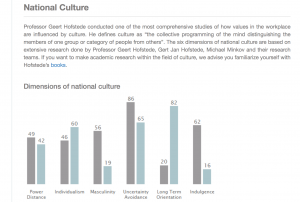Hayley & Dylan
Why is diversity in the classroom important?
I believe that it is important to be a teacher who supports diverse learners and who promotes social justice because our world is becoming more diverse everyday. Excluding diversity from the classroom would be unfair to not only students from diverse backgrounds, but also to any other student. Furthermore, it has been proven that “values in the workplace are influenced by culture” (Hofstede) which can equally be true in the classroom. If student’s values and cultures are understood, teachers will be better able to get students to accept the material. Creating a welcoming classroom environment for every student regardless of their background is one of my highest priorities in my classroom. Professor Geert Hofstede created a study of how differences in cultures affect the work place as featured below:
How does a teacher supportive of diverse learners behave?
A teacher supportive of diverse learning will make sure to include the cultures and beliefs of students inside of the classroom as well as teaching other cultures the students may have never otherwise encountered. I love the idea of having a poem or prompt at least once a week about diversity or focusing on other cultures. Many of the English objectives for the year can be focused on diversity and teachers can even plan these units in advance with the grade level’s history teacher to have the classes connected. English teachers, in particular, should be inclusive in the classroom because
“Through critical, self-reflexive practices embedded in our research and our teaching, we can work against racial, cultural, linguistic, and socioeconomic inequalities by creating humane classrooms where students and teachers learn to use language and literacy in critical and empowering ways” (NCTE).
I plan to encourage my students to learn as much as they can about other cultures because I believe that is it a teacher’s responsibility to help students learn to be empathetic and to understand multiple perspectives. Furthermore, it is important for teachers who want to be seen as accepting and inclusive to behave in a respectful way to all students and make sure to reflect on the way each student is treated. It is often difficult to step outside our own prejudices, however, constant reflection and student feedback will be essential to learning how to deal with our prejudices to create the best possible learning environment for students.
“Supporting Linguistically and Culturally Diverse Learners in English Education.” NCTE Comprehensive News. N.p., n.d. Web. 13 Sept. 2016.
Geert Hofstede, Gert Jan Hofstede, Michael Minkov, Cultures and Organizations: Software of the Mind. Revised and Expanded 3rd Edition. New York: McGraw-Hill USA, 2010


I am so glad to see you take personal responsibility for making this happen in your classroom!
Hey Danielle,
Great blog post! I love how you included diversity in how we should teach social justice as a whole. That is something that we could really use in the teaching field because it’s not just the U.S. that we could concentrate on as far as social justice for diversity, but also around the world to really know what’s going on around us. We do need to address these carefully I agree, because like we talked about in class, there is that sensitivity we have to be careful of when talking about other cultures.
Diversity and social justice play a huge role together, especially for those students who are either discriminated against, or bullied. When we combine the essence of social justice and our knowledge of their culture, and have them teach us about theirs, there’s no limit to what we can do to help them gain that strength back not just for themselves, but for all the diverse students.